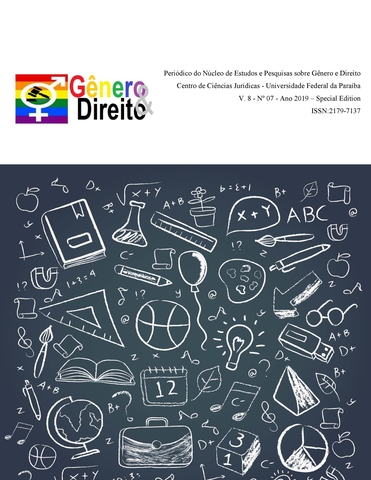EXPRESSIVE SYNTACTIC STRUCTURES IN M.E. SALTYKOV-SHCHEDRIN'S ARTISTIC DISCOURSE
DOI:
https://doi.org/10.22478/ufpb.2179-7137.2019v8n7.49980Palavras-chave:
M.E. Saltykov-Shchedrin’s idiomatic style, expressive syntax, hypotaxis, intensity, phrase model, modus meaning, relational meaningResumo
The article is dedicated to the research of expressive syntactic structures in M.E. Saltykov-Shchedrin’s artistic discourse that received major or minor types and phraseological statuses. By strikingly combining and synthesizing real and fictional things, writer reaches the heights of satirical imagery. It should be noted that, judging by the satirical nature of his works, the intensity semantics (exaggeration or hyperbole) carries a strong importance, while the wide specter of hypotaxis-based sentences is used as a means of its realization. Syntactic units of idiomatic structure that express intensity-consequential, concession-amplification, temporal-concession and other relations are differentiated by their semantic diversity, merging of informative and connotative meanings, combination of real and surreal contents, combination of stable and variable components. The expressions created by the tak/takoj/nastol'ko/do togo/do takoj stepeni…chto; slishkom/chereschur…chtoby; chto (by) ni/kak (by) ni…a; uzh na chto…a; ne uspeet…a (kak); eshche ne..., a uzh scheme are related to the phrase models mentioned above. They are formed on the base of constant components that make up sentence’s carcass, which provides free lexical filling. Meanwhile, the sphere of relational meanings is complicated by the modus-expressive meanings. Semantics of contrast, unusualness, suddenness (subjective hyperbolization that does not match the objective state of affairs, combining of incompatible, shift of moral orientations, combination of real and potential plans etc.) contributes to the appearance of the comical or sarcastic effect. In the functional and textual aspect, the analyzed phrase models become the leading means of presenting speaker’s position in the comprehension of world’s moral picture
Downloads
Referências
Skovorodnikov A.P. Ekspressivnye sintaksicheskie konstrukcii v sovremennom russkom literaturnom yazyke. [Expressive syntactic constructions in modern Russian literature language.] Tomsk, 1992. 261 p.
Nurullina G.M., Yuan Tao, Sajakhova L.G., Usmanova L.A. Wind's Element in the Artistic World of Ivan Bunin: Semantic Strategies and Dominants // TARIH KULTUR VE SANAT ARASTIRMALARI DERGISI-JOURNAL OF HISTORY CULTURE AND ART RESEARCH. 2017, Vol. 6, Is. 5, рр.377–383
Nurullina G.M., Usmanova L.A. The Idiostyle of I. A. Bunin: Emotive and Semantic Dominants in Description of Natural Phenomena // Journal of Language and Literature, 2016, 7 (3), pp. 199–202
M. E. Saltykov-Shchedrin v vospominaniyah sovremennikov: Seriya literaturnyh memuarov [M. E. Saltykov-Shchedrin in the memories of his contemporaries: Series of literature memoirs.] M., 1975. Т. 1–2
Russkie pisateli: Biobibliograficheskij slovar' [Russian writers: Biobibliographical vocabulary]: 2 t. М., 1990. T. 2. p. 209–218
Wierzbicka A. Understanding Cultures through their Key Words (English, Russian, Polish, German and Japanese), Oxford, Oxford University Press, 1997, 328 p.
Nacicsione A. Phraseological units in discourse: Towards applied stylistics, Riga, Latvian Academy of Culture, 2001, 239 p.
Langoltz A. Idiom Creativity: A cognitive Linguistic Model of Idiom-Representation and Idiom-Variation in English, Amsterdam, Philadelphia: John Benjamins Publishing Company, 17, 2006, 325 p.
Shkurko V.Yu., Lukoyanova Yu.K., Sergeeva E. Using Fictional Texts In Teaching Russian As A Second Native Language // Modern Journal of Language Teaching Methods. 2017, Vol. 7, Is. 10, рр. 59–63
Faizullina N., Fattahova N. Sign nature of the riddle: Ecolinguistic aspect // Journal of Language and Literature, 2016, Vol. 7, Is. 2, pp. 336–339
Efimov A.I. Istoriya russkogo literaturnogo yazyka: Kurs lekcij. [History of Russian literature language: Lecture courses.] М., 1954. p. 332–344
Saltykov-Shchedrin M.E. Full composition of writings: 20 t. М., 1972. T. 9, 14
Wierzbicka A. Sravnenie – Gradaciya – Metafora // Teoriya metafory. [Comparison – Gradation – Metaphor. Theory of metaphor] М., 1990. С. 133–152
Pakdel, M., & Talebbeydokhti, A. (2018). The Effect of Adjustment Announcement of Predicted Profit on Price and Trading Volume of Listed Companies in Tehran Stock Exchange. Dutch Journal of Finance and Management, 2(1), 49. https://doi.org/10.29333/djfm/5825
Gutiérrez-Artacho, J., & Olvera-Lobo, M. (2017). Web Localization of Spanish SMEs: The Case of Study in Chemical Sector. Journal of Information Systems Engineering & Management, 2(3), 15. https://doi.org/10.20897/jisem.201715
García-Santillán, A., Ochoa-Domínguez, T. E., & Ramos-Hernández, J. J. (2018). Anxiety towards Mathematics of Workers in the Production Area of a Sugar Mill in Veracruz, Mexico. International Electronic Journal of Mathematics Education, 13(3), 207-219. https://doi.org/10.12973/iejme/3879
Nuriyev, M., Sovetkanova, D., & Seysenbayeva, Z. (2018). Achievements and new challenges in the area of education of independent Kazakhstan. Opción, 34(85-2), 337-352

